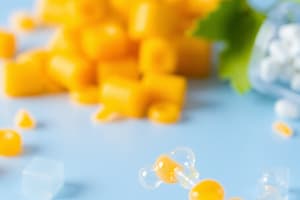Podcast
Questions and Answers
What type of polysaccharide is heparin sulfate?
What type of polysaccharide is heparin sulfate?
- Unsulfated polysaccharide
- Structural polysaccharide
- Branched polysaccharide
- Sulfated polysaccharide (correct)
What is the function of heparin sulfate in the body?
What is the function of heparin sulfate in the body?
- Conversion of galactose to glucose
- Component of cell-surface proteoglycans in mast cells (correct)
- Regulation of blood sugar levels
- Structural support to ligaments and tendons
What is the difference between heparin and heparin sulfate?
What is the difference between heparin and heparin sulfate?
- Heparin is an autoimmune condition and heparin sulfate is not
- Heparin sulfate is smaller and not linked to a protein core (correct)
- Heparin is smaller and linked to a protein core
- Heparin is found in mast cells and heparin sulfate in endothelial cells
What is galactosemia?
What is galactosemia?
What is the main characteristic of type 1 diabetes?
What is the main characteristic of type 1 diabetes?
Which of the following is NOT a symptom of diabetes?
Which of the following is NOT a symptom of diabetes?
What is the function of chondroitin sulfate?
What is the function of chondroitin sulfate?
What type of diabetes occurs during pregnancy?
What type of diabetes occurs during pregnancy?
What is the main difference between type 1 and type 2 diabetes?
What is the main difference between type 1 and type 2 diabetes?
What is the main symptom of polyphagia?
What is the main symptom of polyphagia?
Flashcards are hidden until you start studying
Study Notes
Carbohydrates
- Two main uses of carbohydrates by plants:
- As a structural component (Cellulose)
- As an energy reserve (Starch)
- Dietary intake of plant materials is the major carbohydrate source for humans and animals
- The average human diet should ideally be about two-thirds carbohydrate by mass
Oligosaccharides
- Raffinose is a naturally occurring oligosaccharide found in onions, cabbage, broccoli, Brussels sprouts, whole wheat, and all types of beans
- Polysaccharides are polymeric carbohydrates that contain many monosaccharide units covalently bonded to each other
- Examples of polysaccharides include Starch and Glycans (often called as glycans)
Functions of Carbohydrates in Humans
- Provide energy through oxidation process
- Supply carbon atoms
- Linked to lipids are structural components of cell membranes
Stereoisomerism
- Stereoisomers are isomers that have the same molecular and structural formulas but differ in the orientation of atoms in space
- Enantiomers are nonsuperimposable mirror images of each other
- Diastereomers are stereoisomers whose molecules are not mirror images of each other
Fischer Projection Formula
- A Fischer Projection Formula is a two-dimensional structural notation for showing the spatial arrangement of groups about chiral centers in molecules
- Optically Active Compounds are compounds that rotate the plane of polarized light
- Dextrorotatory Compounds are chiral compounds that rotate the plane of polarized light in a clockwise direction (dextro = “right”)
Parameters to Distinguish Polysaccharides
- Identity of the monosaccharide repeating unit(s) in the polymer chain
- Length of the polymer chain
- Type of glycosidic linkage between monomer units
- Degree of branching of the polymer chain
Types of Polysaccharides
- Storage Polysaccharides (e.g., Starch and Glycogen) used as an energy source in cells
- Structural Polysaccharides (e.g., Cellulose and Chitin) serve as a structural element in plant cell walls and animal exoskeletons
- Acidic Polysaccharides (e.g., Hyaluronic Acid and Heparin) have a negative charge due to a sulfate group or a carboxyl group
Glycosaminoglycans (GAGs)
- Large linear polymers of repeating disaccharide units
- Found outside the cells, part of extracellular matrix, and attached to the protein core to form proteoglycans
- Examples: Heparin Sulfate, Chondroitin Sulfate, Dermatan Sulfate, and Keratan Sulfate
Other Natural Polysaccharides of Interest
- Agar: a linear polymer of sulfated and unsulfated galactose prepared from marine algae – agarose
- Inulin: a polysaccharide of fructose, readily soluble in water, and used to determine the glomerular filtration rate
- Dextrins: intermediates in the hydrolysis of starch
Carbohydrate-Related Diseases
- Diabetes: a chronic health condition that affects how the body turns food into energy
- Symptoms of Diabetes: Polyuria, Polydipsia, and Polyphagia
- Types of Diabetes: Type 1, Type 2, and Gestational
- Galactosemia: a rare, hereditary disorder of carbohydrate metabolism that affects the body’s ability to convert galactose to glucose
Studying That Suits You
Use AI to generate personalized quizzes and flashcards to suit your learning preferences.




